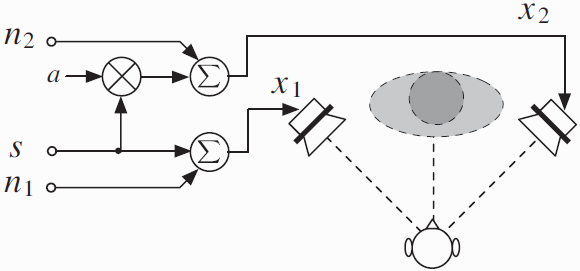10.3 Spatial decomposition of stereo signals
Stereo signals are recorded or mixed such that for each source the signal goes coherently into the left and right signal channel with specific directional cues (level difference, time difference) and reflected/reverberated independent signals go into the channels determining auditory object width and listener envelopment cues. This motivates modeling single source stereo signals, as illustrated in Figure 10.1, where the signal s mimics the direct sound from a direction determined by the factor a. The independent signals, n1 and n2, correspond to the lateral reflections. These signals are assumed to have the following relation with the stereo signal pair x1, x2:

In order to get a decomposition which is not only effective in a one auditory object scenario, but nonstationary scenarios with multiple concurrently active sources, the described decomposition is carried out independently in a number of frequency bands and adaptively in time:


Figure 10.1 Mixing a stereo signal mimicking direct sound s and lateral reflections n1 and n2. The factor A determines the direction at which the auditory object appears.
Figure 10.2 Each left and right time–frequency ...
Get Spatial Audio Processing: MPEG Surround and Other Applications now with the O’Reilly learning platform.
O’Reilly members experience books, live events, courses curated by job role, and more from O’Reilly and nearly 200 top publishers.

